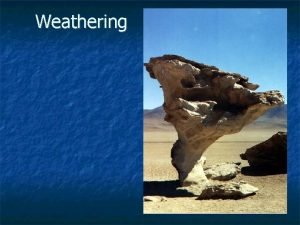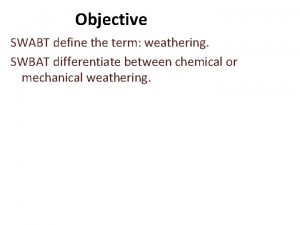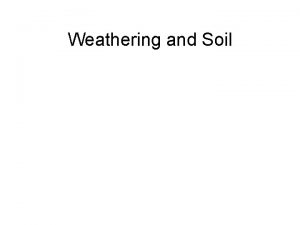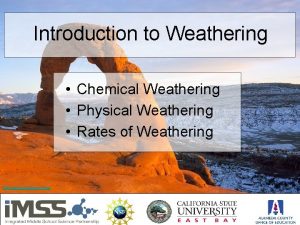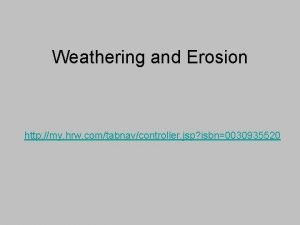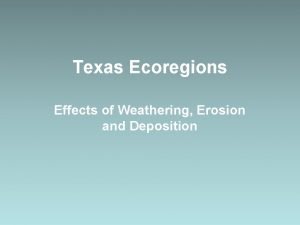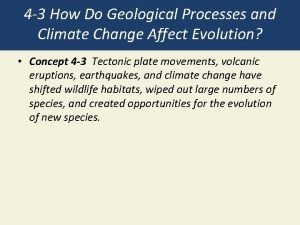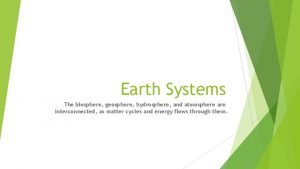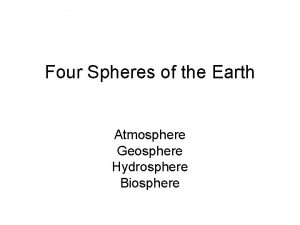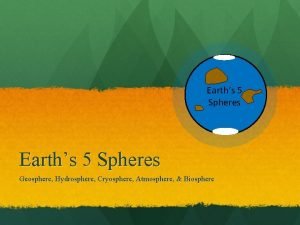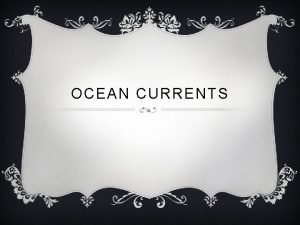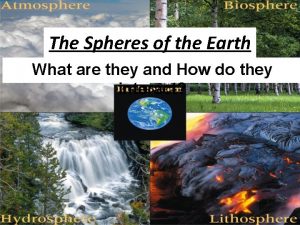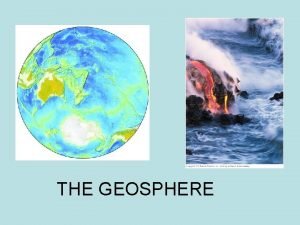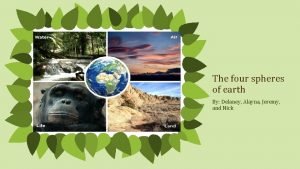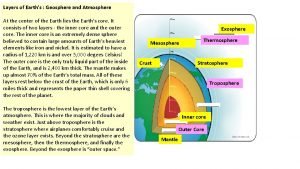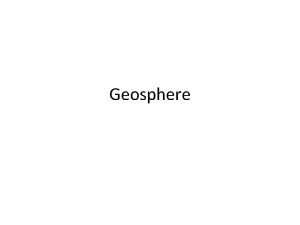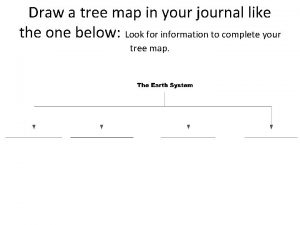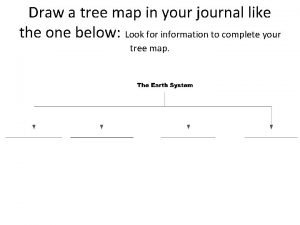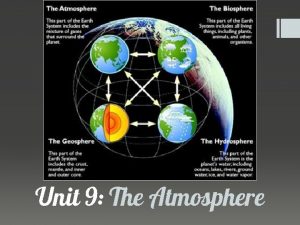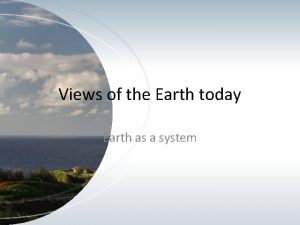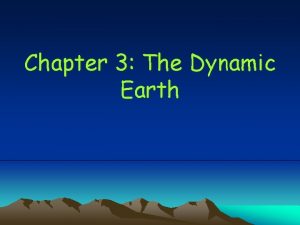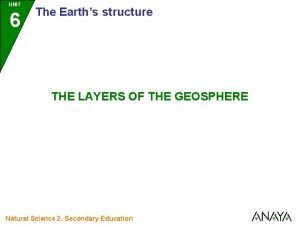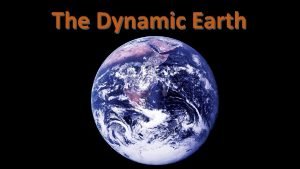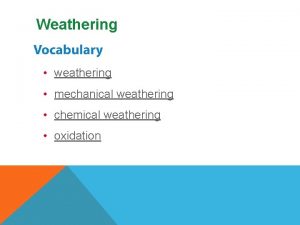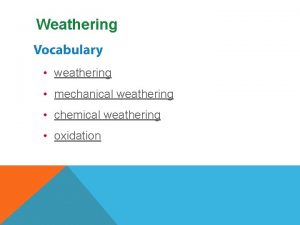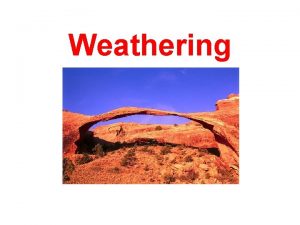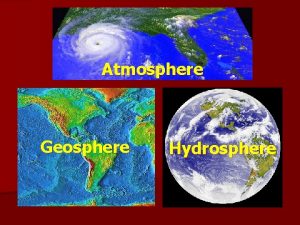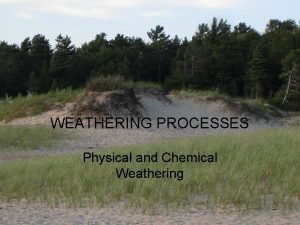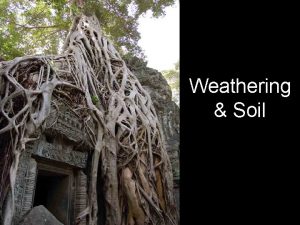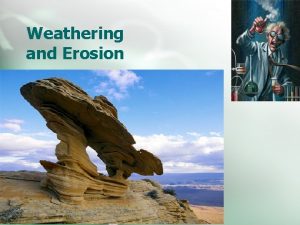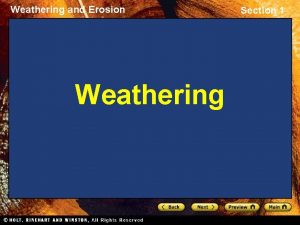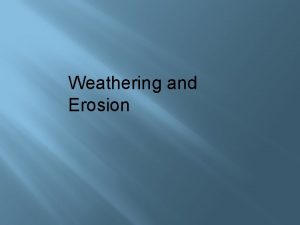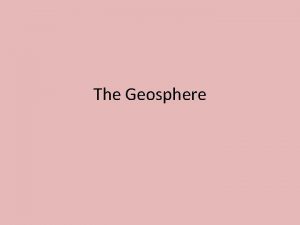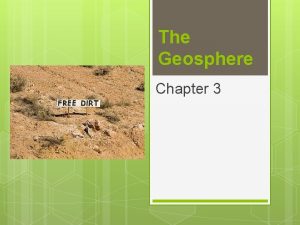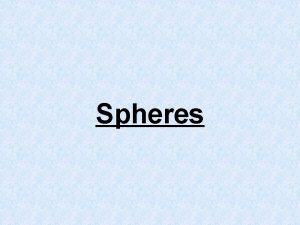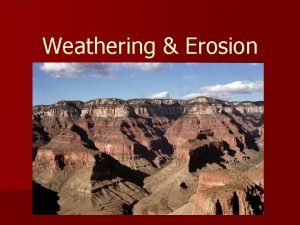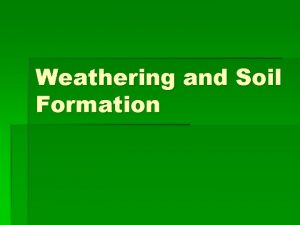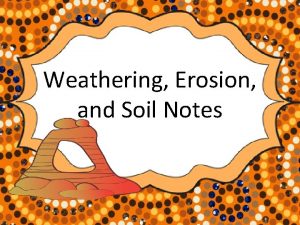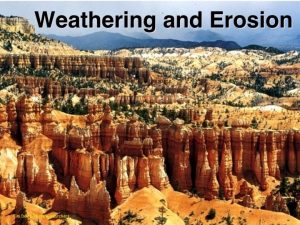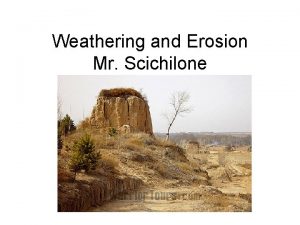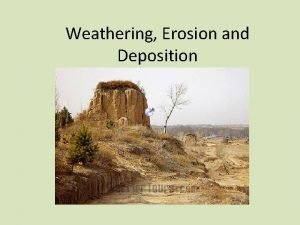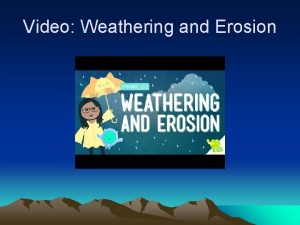Surface Processes that affect the Geosphere Weathering and























































- Slides: 55

Surface Processes that affect the Geosphere: Weathering and Erosion (How large rocks turn into smaller ones)

Foot prints on the moon are still there.

Weathering • Weathering describes the breaking down or chemically altering of rocks and minerals on the surface to become sediment. • Water, ice, acids, salts, plants, animals, and changes in temperature all agents of weathering. • Can be Mechanical, Chemical or Biological

Mechanical (Physical) Weathering • Minerals remain unchanged. • Types of mechanical weathering: • Freeze-thaw • Exfoliation • Abrasion • Plants and Animals

Freeze-thaw (Ice-wedging) • Occurs when water continually seeps into cracks, freezes and expands, eventually breaking the rock apart. • https: //www. geolsoc. org. uk/ks 3/gsl/education/resources/rockcycle/page 4268. html

Ice Wedging • Cycles of freezing and thawing can cause ice wedging, which can break rock into pieces: • Water seeps into cracks in a rock. • When the water freezes, it expands. • The ice pushes against the cracks causing cracks to widen. • When the ice melts, the water seeps further into the cracks. • As the cycle repeats, the cracks get bigger. • Finally, the rock breaks apart.

Exfoliation • Sheets of rock loosened • Results in exfoliation domes • https: //www. youtube. com/watch? v=Wk. Eh 0 MLCNRE

Abrasion • Abrasion - When rocks rub against each other and become rounded.

Abrasion by Wind “desert varnish. ” Eg. Arches National Park, Utah

Ventifacts – stones shaped by wind

Plants and Animals • Animals can walk on rock or disturb it, causing landslides that scrape or smooth rock surfaces. • Burrowing animals such as badgers and moles can break up rock underground or bring it to the surface, where it is exposed to other weathering forces.

Plant Growth (Biological) • Lichen and mosses wedge tiny roots into pores and crevices of rocks • Tree roots

Name 5 Agents of Mechanical Weathering

Agents of Mechanical Weathering • Wind, water, ice, plants, animals

Chemical Weathering • Chemical weathering refers to the processes by which rocks react with the atmosphere to form new substances. • These reactions can alter a rock and transform the rock into sand, clays, and other minerals. • Agents of Chemical Weathering: Water, oxygen, carbon dioxide, acids of plant decay

Rock formed deep under ground become more susceptible as they reach the surface. • Most minerals form at high pressure or high temperatures deep in the crust, or sometimes in the mantle. • When these rocks reach the Earth’s surface, they are now at very low temperatures and pressures. • This is a very different environment from the one in which they formed and the minerals are no longer stable. • In chemical weathering, minerals that were stable inside the crust must change to minerals that are stable at Earth’s surface. • The minerals that form at the highest temperatures and pressures are the least stable at the surface. Clay is stable at the surface and chemical weathering converts many minerals to clay.

Reaction with Water • The positive side of the molecule attracts negative ions and the negative side attracts positive ions. • So water molecules separate the ions from their compounds and surround them. • Water can completely dissolve some minerals, such as salt.

Reaction with Water • Hydration: New substance created when water is absorbed (water molecule used to form a bond). Eg. As the mineral anhydrite reacts with groundwater, it transforms into gypsum, one of the most common minerals on Earth.

Reaction with Water: Hydrolysis • Hydrolysis: New substance created when water molecule cleaves (breaks) chemical bonds. • Eg. Mineral potassium feldspar (in granite rock) is leached of potassium and changed into a clay mineral.

Hydrolysis • When potassium feldspar reacts with slightly acidic water, it can be transformed into kaolinite, a clay mineral: 4 KAl. Si 3 O 8 + 4 H+ + 2 H 2 O → 4 K+ + Al 4 Si 4 O 10(OH)8 + 8 Si. O 2 (potassium feldspar) + (hydrogen ion) + (water) → (potassium ion) + (kaolinite) + (silica) • Granitic pebbles within the rock have weathered, partly through hydrolysis, into kaolin (seen as white spots in the picture above).

Dissolution • Dissolution is when a mineral completely dissolves in water. • especially in rocks that contain either magnesium carbonate or calcium carbonate, which easily dissolve in water or other acidic solutions (often carbonic acid - the result of a reaction between carbon dioxide and water). • Ca. CO 3 + H 2 CO 3 → Ca 2+ + 2 HCO 3– • (calcite) + (carbonic acid) → (calcium ion) + (bicarbonate ion)

Dissolution • Rainwater falling on this rock, and flowing along fractures in the rock, has slowly dissolved some of the limestone to create pits and channels.

Dissolution -> Karst • Soluble rocks such as limestone, dolomite, and gypsum can be dissolved and carried away leaving behind huge land forms called Karst.

Dissolution Karst • One of the world’s most spectacular examples of karst is Shilin, or the Stone Forest, near Kunming, China. • Hundreds of slender, sharp towers of weathered limestone rise from the landscape.

Carbonation: Reaction with Carbon Dioxide • Carbon dioxide from the air or soil can combine with water to form carbonic acid, a weak acid that can dissolve rock. • Carbonic acid is especially effective at dissolving limestone.

Carbonation • When carbonic acid seeps through limestone underground, it can open up huge cracks or hollow out vast networks of caves.

Carbonation • Carlsbad Caverns National Park, New Mexico, includes more than 119 limestone caves created by weathering and erosion. • The largest is called the Big Room. It is the size of six football fields.

Oxidation: Reaction with Oxygen • Oxygen is very strongly reactive. • Minerals rich in iron break down as the iron oxidizes and forms new compounds. • As rust expands, it weakens rock and helps break it apart. • Iron oxide produces the red color in soils.

Oxidation • the oxidation of pyroxene into limonite and dissolved silica: • 4 Fe. Si. O 3 + O 2 + H 2 O → 4 Fe. O(OH) + 4 Si. O 2 • (pyroxene) + (oxygen) + (water) → (limonite) + (silica) Uluru, also known as Ayers Rock, is a sandstone which gets its coloring from the oxidation of iron-bearing minerals.

Factors Affecting Rates of Weathering: 1. Rocks themselves – how resistant they are

Weathering also depends on Rock and Mineral Type • Rocks that resist weathering remain at the surface and form ridges or hills. Devil’s Tower in Wyoming is an igneous rock from beneath a volcano • As the surrounding less resistant rocks were worn away, the resistant center of the volcano remained behind.

Rock and Mineral Type; • Mineral such as Quartz is hard, no cleavage makes it resistant to weathering. • Igneous rocks, especially intrusive igneous rocks such as granite, weather slowly because it is hard for water to penetrate them. • Other types of rock, such as limestone, are easily weathered because they dissolve in weak acids.

2. Amount of surface area exposed • Mechanical weathering increases the rate of chemical weathering. • As rock breaks into smaller pieces, the surface area of the pieces increases.

3. Climate: Warm, wet climates favor chemical weathering Cold, dry climates favor mechanical weathering

Factors affecting Weathering: Climate • Climate is determined by the temperature of a region plus the amount of precipitation it receives. • Chemical weathering increases as: • As temperature increases so does rate of chemical reactions. For each 10 o. C increase in average temperature, the rate of chemical reactions doubles. • As precipitation increases so does amount of chemical reactions. Water causes both mechanical and chemical weathering.

Climate • A cold, dry climate will produce the lowest rate of weathering. • A warm, wet climate will produce the highest rate of weathering. • The warmer a climate is, the more types of vegetation it will have and the greater the rate of biological weathering.

Which Rocks and Minerals Resist Most? • Most igneous rocks and many metamorphic rocks weather more rapidly in wet climates than in dry ones. • They often have cracks that are widened by mechanical weathering, contain minerals that are easily affected by chemical weathering

Which Rocks and Minerals Resist Most? • Sedimentary rocks are only as strong as their cement holding them together. • Those with silica or quartzite as a cement are more durable. • Shale is weakest of all sedimentary rocks, easily split. • Marbles and limestones are fairly resistant to mechanical weathering (except calcite often found in marble reacts to acid). • Limestones last longer in dry climates because where there is very little dissolved acid.

What is Erosion? • Erosion is the removal and transport of earth materials by natural agents. • Agents of Erosion: Wind, Water, Ice

Erosion by Water • Rain, rivers, floods, lakes, and the ocean carry away bits of soil and sand, and slowly wash away the sediment.


Erosion by Ice: Glaciers are large slabs of ice. As glaciers move, they transport everything in their path, from tiny grains of sand to huge boulders. • Abrasion is the process in which a glacier scrapes underlying rock • Glacial striations are scratches and grooves that show the direction the glacier moved.

Erosion by Ice: Glaciers • Plucking is the process by which rocks and other sediments are picked up by a glacier. • They freeze to the bottom of the glacier and are carried away by the flowing ice. • Glacier sediment deposits are called moraine.

Erosion by Ice Moving glaciers gouge out basins and form steep-sided mountain valleys.

Erosion by Wind • Aeolian (wind-driven) processes constantly transport dust, sand, and ash from one place to another. • Wind can sometimes blow sand into towering dunes. • Eg. Sand dunes of Badain Jaran section of the Gobi Desert in China, reach more than 400 m high.

Erosion by Gravity • Landslides and other forms of mass wasting • These processes cause rocks to dislodge from hillsides and crumble as they tumble down a slope.

Frank Slide 1903 It is the deadliest landslide in Canadian history and was the largest until the Hope Slide in 1965.

What is the difference between Weathering and Erosion?

What is the difference between Weathering and Erosion • Weathering is the breakdown or dissolving of rock but does not involve movement. • Erosion is the movement of material

Check in 1. Which rocks are most resistant to chemical and physical weathering? 2. Why? 3. Which are most susceptible? 4. What kind of climate promotes weathering? 5. What types of rocks are susceptible to chemical weathering?

Check in 1. Which rocks are most resistant to chemical and physical weathering? Quarts 2. Why? Hard, no cleavage 3. Which are most susceptible? Shale is weakest – splits easily, 4. What kind of climate promotes weathering? Warm, damp 5. What types of rocks are susceptible to chemical weathering? Those containing calcite are susceptible to acid.

Summary • Mechanical weathering breaks rocks into smaller pieces without changing their composition. • Ice wedging and abrasion are two important processes of mechanical weathering. • Chemical weathering breaks down rocks by forming new minerals that are stable at the Earth's surface. • Water, carbon dioxide, and oxygen are important agents of chemical weathering. • Different types of rocks weather at different rates. More resistant types of rocks will remain longer.

Can you answer these? 1. 2. 3. 4. 5. 6. 7. What are the four forces of erosion and which is responsible for the most erosion? Name two types of mechanical weathering. Explain how each works to break apart rock. What are three agents of chemical weathering? Give an example of each. What type of climate would likely produce the greatest degree of weathering? Explain. What causes differential weathering in a rock? Would a smooth even surface weather faster than an uneven, broken surface? What type of rocks would be best suited to making monuments?

Consider the following • What other types of surfaces are affected by weathering other than rock? • What might the surface of the Earth look like if there was no weathering? Think about the Moon or other planets. • Do you think that you would be alive today if water did not dissolve elements? • Would the same composition of rock weather the same way in three very different climates?

Homework • Read pages 131 -136 • Answer #1 -6 p 137 • Next Class: Weathering Simulation Lab
 Types of chemical weathering
Types of chemical weathering Weathering
Weathering Weathering and its types
Weathering and its types Introduction to weathering
Introduction to weathering How does weathering affect the gulf coast plains?
How does weathering affect the gulf coast plains? Weathering
Weathering Piney woods deposition
Piney woods deposition Deposition in trans pecos
Deposition in trans pecos How do geological processes affect natural selection
How do geological processes affect natural selection Phân độ lown ngoại tâm thu
Phân độ lown ngoại tâm thu Premature atrial contraction
Premature atrial contraction Thơ thất ngôn tứ tuyệt đường luật
Thơ thất ngôn tứ tuyệt đường luật Thơ thất ngôn tứ tuyệt đường luật
Thơ thất ngôn tứ tuyệt đường luật Chiến lược kinh doanh quốc tế của walmart
Chiến lược kinh doanh quốc tế của walmart Tìm độ lớn thật của tam giác abc
Tìm độ lớn thật của tam giác abc Hãy nói thật ít để làm được nhiều
Hãy nói thật ít để làm được nhiều Tôn thất thuyết là ai
Tôn thất thuyết là ai Gây tê cơ vuông thắt lưng
Gây tê cơ vuông thắt lưng Sau thất bại ở hồ điển triệt
Sau thất bại ở hồ điển triệt Concurrent in os
Concurrent in os Hydrosphere includes *
Hydrosphere includes * Earth systems
Earth systems Geosphere examples
Geosphere examples Biosphere and geosphere
Biosphere and geosphere 5 spheres of earth
5 spheres of earth How does water purity affect surface tension hypothesis
How does water purity affect surface tension hypothesis Factors that affect surface currents
Factors that affect surface currents Biosphere examples
Biosphere examples Geosphere elements
Geosphere elements Defintion of biosphere
Defintion of biosphere Geosphere layers
Geosphere layers What is in the geosphere
What is in the geosphere Hydrosphere concept map
Hydrosphere concept map How to draw a tree map
How to draw a tree map Exosphere
Exosphere What is geosphere made of
What is geosphere made of Geosphere
Geosphere Chapter 3 the dynamic earth section 1 the geosphere
Chapter 3 the dynamic earth section 1 the geosphere Geosphere diagram
Geosphere diagram Geosphere diagram
Geosphere diagram Geosphere
Geosphere Curved surface area of cone
Curved surface area of cone What is lateral face
What is lateral face Spin coat
Spin coat Hình ảnh bộ gõ cơ thể búng tay
Hình ảnh bộ gõ cơ thể búng tay Lp html
Lp html Bổ thể
Bổ thể Tỉ lệ cơ thể trẻ em
Tỉ lệ cơ thể trẻ em Voi kéo gỗ như thế nào
Voi kéo gỗ như thế nào Chụp phim tư thế worms-breton
Chụp phim tư thế worms-breton Alleluia hat len nguoi oi
Alleluia hat len nguoi oi Kể tên các môn thể thao
Kể tên các môn thể thao Thế nào là hệ số cao nhất
Thế nào là hệ số cao nhất Các châu lục và đại dương trên thế giới
Các châu lục và đại dương trên thế giới Cong thức tính động năng
Cong thức tính động năng Trời xanh đây là của chúng ta thể thơ
Trời xanh đây là của chúng ta thể thơ
